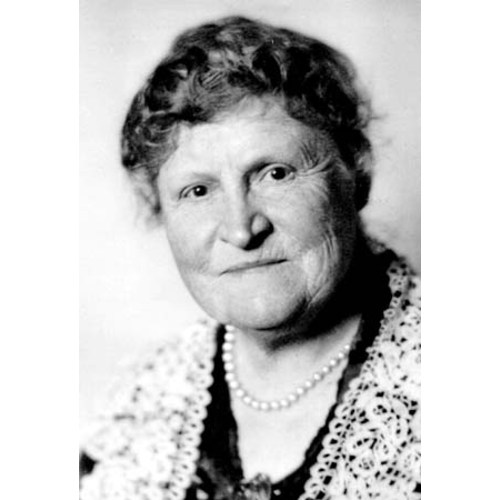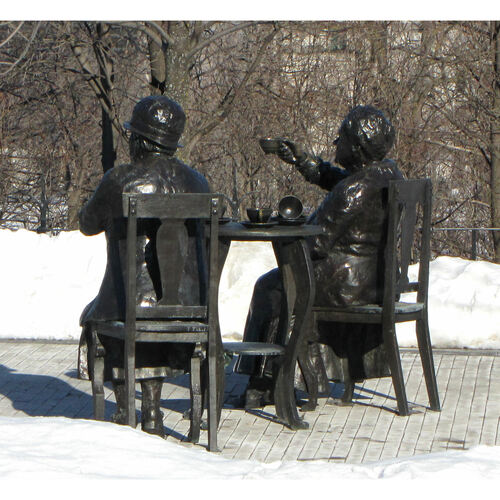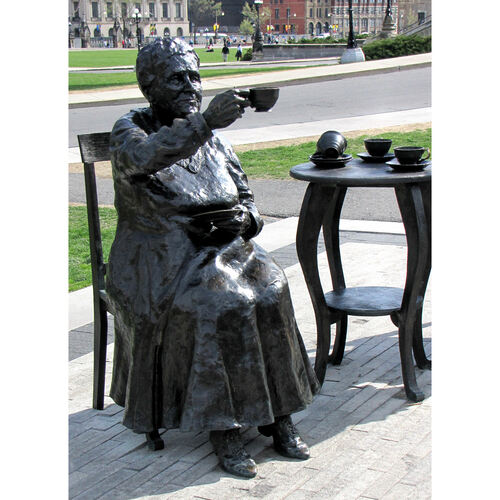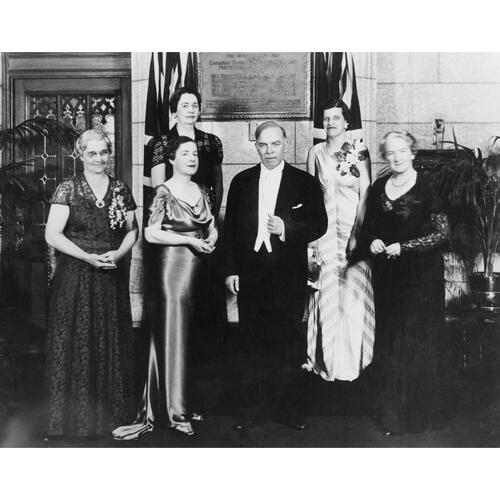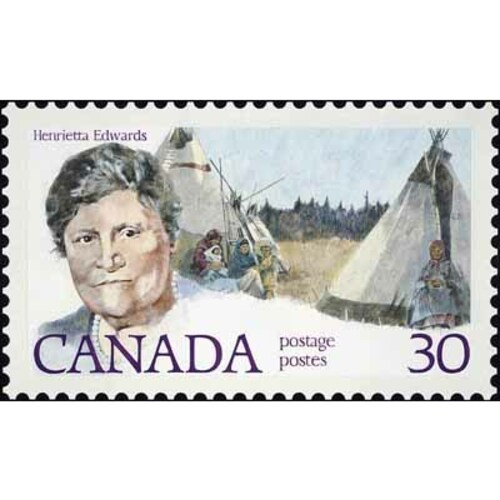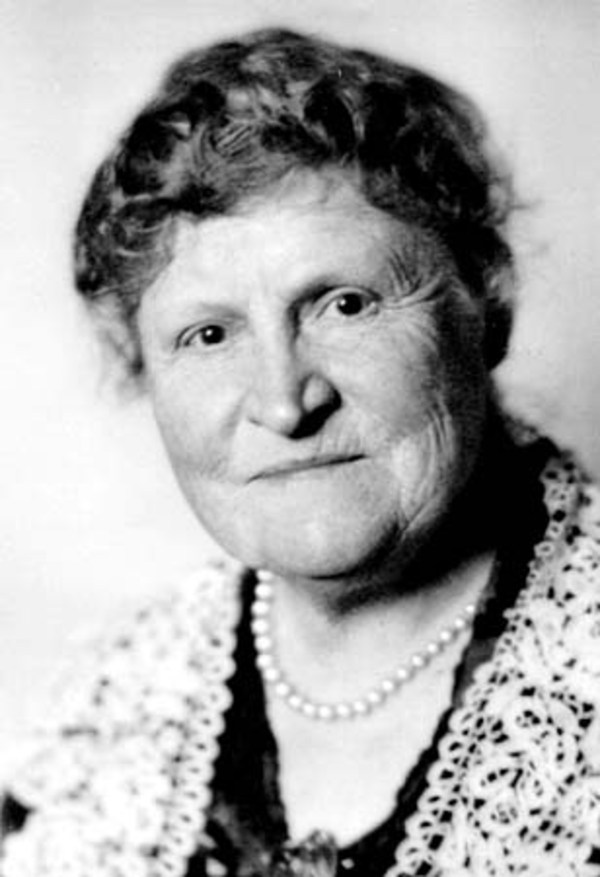
Source: Courtesy of Wikimedia Commons
MUIR, HENRIETTA LOUISE (Edwards), feminist activist, artist, and legal expert; b. 18 Dec. 1849 in Montreal, daughter of William Muir and Jane Johnston; m. there 12 Sept. 1876 Oliver Cromwell Edwards, and they had two daughters and a son; d. 9 Nov. 1931 in Fort Macleod, Alta.
Henrietta Muir Edwards’s feminist activism spanned more than 55 years, an unusual career in both length and focus for the period. At a young age she learned that Christian service was expected in the Muir family. Her paternal grandparents had emigrated from Scotland to Montreal, where they developed a successful merchant-tailoring firm, built the first Baptist chapel, and founded and supported numerous denominational organizations. Raised in this prosperous Protestant environment, their ten children became, or married, accomplished professionals and business leaders, and expanded their parents’ evangelical commitment by generally supporting women’s education. William Muir joined the family firm. In contrast, Henrietta’s mother, Jane Johnston, the eldest of 14 children born into a Scots Presbyterian family, spent her youth raising her siblings. Jane’s father, a widower, struggled to support the family with earnings from his Montreal bake-shop. After marrying into the affluent Muir family, Jane gave birth to eight children; six survived to adulthood, all of them raised in her husband’s religious tradition. The eldest two, Amelia and Henrietta, became very close and would live together for most of their lives.
Henrietta, who was named after the Swiss Baptist missionary Henriette Feller [Odin*], enjoyed a privileged childhood, receiving a rigorous religious upbringing complemented by an eclectic secular education. Her father hired Scottish governesses, as well as art and music teachers, and sent his daughters to Montreal ladies’ academies. Henrietta’s extant diary records the hopes, dreams, and fears of an outspoken, independent 14-year-old whose behaviour frustrated her severe mother more than her more tolerant father. A patron of the Art Association of Montreal, William Muir supported Henrietta’s ambition to become an artist, sending her and Amelia on a European grand tour in 1867–68. Liberal in his social and political views, he discussed local and international developments with his children. Participation in these lively debates set the tone for Henrietta’s later years.
As Henrietta’s adulthood dawned, William continued to encourage her studies while sponsoring the charitable projects she chose to take up. In 1871 she attended lectures given by the Montreal Ladies’ Educational Association, of which her mother was a member; this group, headed by Anne Molson*, lobbied for a women’s college at McGill. The fact that the local Baptist community favoured female suffrage encouraged Henrietta’s nascent feminism, as did the views of her fiancé, Oliver Cromwell Edwards, the youngest son of a prominent Ottawa valley Baptist family, a leader in the Young Men’s Christian Association, and a McGill medical graduate. Following their marriage in 1876, Dr Edwards practised in an office adjacent to the Muir home, where the couple lived. Henrietta soon gave birth to two children, Alice Millicent and William Muir. Supported by her family and their servants, she led an active life. She continued her participation in the local Young Women’s Christian Association (YWCA), of which she had been a founding member in 1874 [see Mary Cowans*], and the Young Women’s Reading Room, which she and Amelia had opened that same year; the latter undertaking became the Working Girls’ Association, an organization that offered boarding facilities and job training in addition to a library and educational classes. In 1878 the sisters, aided by their Baptist connections, created the Montreal Women’s Printing Office, which both instructed and employed women as compositors. The office produced a monthly paper, Woman’s Work in Canada; the first magazine in Canada to be written, designed, and printed by women, it was described by Baptist author and editor Pamelia Sarah Yule [Vining*] as an “excellent and vigorous journal.” The paper publicized Christian projects, such as the sending of a female missionary to India by the Women’s Baptist Foreign Missionary Society of Eastern Canada, which Henrietta and Amelia had helped organize in 1876 and on whose executive they served.
At the Working Girls’ Association, Henrietta opened an art studio, taught pupils, and created illustrations for publications (among them Woman’s Work in Canada), using the training she had received in 1876 at New York’s Cooper Union for the Advancement of Science and Art, where she studied with Wyatt Eaton*, and at the National Academy of Design. In 1882 she exhibited flower paintings with the Royal Canadian Academy of Arts (RCA); during this decade she also sent her work to shows held by the Art Association of Montreal and the Ontario Society of Artists. While some women artists in Canada struggled for professional recognition, Henrietta channelled her creative energy more into charitable work and the new Montreal Society for Decorative Art. Her gracious life in the city ended soon after her husband, whose practice failed to satisfy his adventurous nature, left in 1882 for the North-West Territories, where he obtained a year’s contract to serve as medical officer to the Indigenous bands who adhered to Treaty No.4, including the followers of Payipwat*, Paskwāw*, and Louis O’Soup*; the family joined him at Fort Qu’Appelle (Sask.) in 1883.
Over the next 20 years Henrietta and the children moved across Canada, often living apart from Dr Edwards. Although he returned to private practice in 1883, he continued to chase employment with the Department of Indian Affairs. Throughout the 1880s Oliver, a strong Liberal Party supporter, severely criticized the federal Conservative government for its treatment of First Nations [see Edgar Dewdney*]. Henrietta often travelled with him to District of Assiniboia reserves, where she collected artefacts. She distributed art supplies to an Assiniboin named Hon̄eeӯesa, who produced a series of ledger drawings of Indigenous scenes for the couple. Living close to First Nations people influenced the Edwards family, and Henrietta developed a more benevolent and respectful attitude towards them than was common at the time. With a young family and a frequently absent husband, she relied upon Indigenous women for assistance, especially when she was pregnant with her last child. Throughout the 1880s the family resided in Qu’Appelle and Indian Head, their relative permanency allowing them to help establish schools, hospitals, libraries, churches, and cultural organizations. When Baptist services were not available, they attended Methodist, Presbyterian, and Anglican churches. Active in 1887 in the formation of the first branch of the Woman’s Christian Temperance Union (WCTU) in the North-West Territories, Henrietta became its founding president. She would hold many offices in this nationwide organization over the next three decades.
While Henrietta enjoyed her time in the west, she missed her former life and her relatives. She spent some winters in Montreal and returned to the east with her husband in 1890 for their children’s education. The couple chose Ottawa, a decision that introduced Henrietta to an interdenominational community of dynamic, evangelical women that included Roberta Elizabeth Tilton [Odell*] and Ella Hobday Bronson [Webster*]. Along with Oliver’s extended family, the couple attended First Baptist Church. Henrietta’s maternal feminism encouraged a broader community participation that brought her into contact with women interested in public speaking and political action, including suffrage and temperance work. Within three years she had claimed a place on the executives of ten women’s organizations.
Through the Ottawa WCTU she took part in the campaigns for a plebiscite on Prohibition and became involved in the annual petitions to the federal government requesting votes for women. Inspired by Ann Augusta Stowe* Gullen’s election as a Toronto school trustee in 1892 and her creation of the Dominion Women’s Enfranchisement Association (DWEA), Henrietta enthusiastically embraced the suffrage cause. In addition, as one of the managers at the Home for Friendless Women, she joined with its founder, Bertha Hannah Wright*, in organizing the Ottawa YWCA in 1892, and she became its president two years later. Other involvements in the capital included the Women’s Baptist Home Missionary Society of Eastern Ontario and Quebec, on whose board she would serve from 1893 to 1902. Her overriding preoccupation, however, was an organization inspired by Lady Aberdeen [Marjoribanks], wife of the new governor general: the National Council of Women of Canada (NCWC), founded in 1893. When the Ottawa Local Council of Women (LCW) was formed the following year, Henrietta was elected treasurer, despite Lady Aberdeen’s misgivings that she was “rather aggressively Evangelical for a post which will bring her much in contact with the R.C.’s [Roman Catholics].” Seduced by Lady Aberdeen’s personality, political skills, and “splendid vision,” Henrietta would work for the NCWC for the rest of her life.
Having established an art studio at the YWCA, Henrietta taught and accepted portrait commissions from such important figures as businessman and mp Sir Donald Alexander Smith* and the Liberal leader, Wilfrid Laurier*. She also helped launch and joined the executive of the Ottawa Decorative Art Society, entered the 1892 RCA exhibition, and the following year earned a commission to paint, for Canada’s pavilion at the Columbian exposition in Chicago, a porcelain soup set with local scenes. Selling her work was necessitated by the family’s increasing indebtedness; career advancement and financial security had eluded Dr Edwards, in part because of stiff competition in Ottawa’s medical world. In 1897 Oliver reluctantly returned to the northwest, having secured a contract from the new Laurier government. He lived first in Regina and later travelled with the Treaty No.8 commission [see James Andrew Joseph McKenna*] to vaccinate northern Indigenous peoples. In 1901 he would move to the Blood and Peigan reserves in the southern part of the District of Alberta.
Following Oliver’s departure, Henrietta had relocated to Montreal, where she lived in rented premises with her unmarried sisters. After the exciting activism she had known in Ontario, Quebec’s conservative political climate proved frustrating, but working with such women as Josephine Dandurand [Marchand*], Marie Gérin-Lajoie [Lacoste*], and Professor Carrie Matilda Derick* in the Montreal LCW broadened her perspective by introducing her to a more sophisticated feminism that was particularly concerned with women’s legal rights. In 1899 she succeeded Grace Julia Drummond [Parker*] as convener of the National Council’s committee on laws for the better protection of women and children. She kept this position until her death, making her committee a model for similar bodies in other countries affiliated to the International Council of Women (ICW). By 1901 she had been chosen to serve on the ICW’s committee on laws concerning domestic relations. Her Canadian group compiled legal information from across the country, educated members, and launched campaigns for legislative reforms on such matters as divorce, the raising of the age of consent, and married women’s property rights. Among the prominent women who served on it over the years were Gérin-Lajoie, Stowe Gullen, Edith Jessie Archibald, Agnes Maule Machar*, Helen Letitia McClung [Mooney*], and Alpha Maude Riley [Keen*]. In addition to working for the local and national councils, Henrietta joined the Montreal Women’s Club [see Eliza Ann McIntosh*], remained active in the YWCA, and continued her association with the WCTU, becoming in 1898 dominion superintendent of franchise and Christian citizenship. She was unflagging in her demands for equal voting rights, and she contributed “The political position of Canadian women” to the handbook the NCWC prepared for the universal exposition in Paris in 1900, using both maternal and equal-rights feminist arguments for an expanded political role.
In her private life, Henrietta attended Olivet Baptist Church, teaching Sunday school and listening to Social Gospel sermons on Christian duty from its minister, Ebenezer William Dadson*, and his successor; she eschewed the fashionable world of her younger, wealthy brother William Ebenezer, who built both a mansion and the Baptist church in Westmount. She also carried on with her art, exhibiting ivory and porcelain miniatures at the RCA in 1899 and 1900, but this aspect of her career was about to end with another move west.
The family rejoined Dr Edwards in 1903. Despite their long separations the couple’s marriage had apparently remained an affectionate one. “How I would like to give you an old fashioned tumble and squeeze,” Oliver had written in 1897. “My fingers just itch for a touch of your soft undulations.” Renewed domestic happiness may have ensued, but in her new life Henrietta became isolated on the Blood Indian Reserve, where poor roads, winter blizzards, and spring floods often made travel impossible, even to nearby towns such as Fort Macleod. Dr Edwards attracted controversy, some deserved, some unfair. Partisan political loyalties, a conservative ranching community, and petty jealousy on the part of the local Indian agent made life difficult for the couple. On the other hand, daughter Alice’s marriage in 1907 to Claude William Edward Gardiner, the English owner of a ranch near the Peigan Indian Reserve, expanded the Edwardses’ social circle, especially after grandchildren arrived. In 1909 their son, Muir, accepted a faculty position in mathematics and civil engineering at the University of Alberta, an appointment that connected Henrietta to Edmonton women’s groups and to prominent provincial Liberals such as the university’s president, Henry Marshall Tory*. Often alone on the reserve (her second daughter was studying in Ottawa), Henrietta found companionship at St Paul’s Anglican mission, led by the dynamic Reverend Samuel Henry Middleton. Eventually, her sister Amelia left Montreal to live with her.
Travelling across Canada to attend the annual NCWC and WCTU conventions broke Henrietta’s seclusion. She remained active in the DWEA as well, and after it was reorganized as the Canadian Suffrage Association in 1907, she became vice-president for Alberta. Her work on the NCWC’s law committee linked her to issues of particular importance to prairie women. She joined Louise Cinthia McKinney [Crummy], Emily Gowan Murphy [Ferguson], Francis Marion Beynon*, and other activists in the dower campaign, which sought to restore to women an incontestable interest in marital assets, their traditional rights having been reduced by English legislation in the 1830s and then abolished entirely in the North-West Territories in 1886 to facilitate the easy transfer of title to land. In 1906, when she was superintendent of franchise for the Alberta and Saskatchewan WCTU, she presented to the new Alberta government of Alexander Cameron Rutherford* a petition from the organization requesting the restoration of dower rights. As a suffragist, she found the endless pleading counter-productive: “Year after year we have to go over the same ground wasting time and energy that might be saved if we had the influence of a vote.” Another decade of petitions would elapse before there was any headway on the causes she championed. Only in 1916 did the provincial government of Arthur Lewis Watkins Sifton* grant women the right to vote and ban the selling of intoxicating beverages. Not until 1917 was the matter of dower rights addressed. Although the Dower Act of that year was remedial, it was not progressive legislation, and dower rights remained an issue for many years to come.
As the NCWC’s vice-president for the North-West Territories and subsequently for Alberta, Henrietta rejuvenated the Regina LCW in 1904, and re-established the Local Council in Edmonton four years later and the Calgary organization in 1912. Elsewhere, NCWC work proceeded slowly. Using the expertise she had acquired on the law committee, Henrietta published in 1908 Legal status of Canadian women, a popular resource that earned her speaking engagements and increased her influence within the NCWC and with federal and provincial governments. When delegates were elected to attend the ICW meeting in Toronto in 1909, which she helped organize, she received the second largest number of votes next to Lady Edgar [Ridout*], the NCWC’s president.
Between 1913 and 1916, however, important years for the Alberta Prohibition and suffrage campaigns, family concerns demanded Henrietta’s attention, a situation that isolated her from WCTU leaders such as McKinney and Emily Kerby [Spencer] (who took over as the organization’s superintendent of franchise), Mary Irene Parlby [Marryat*], president of the United Farm Women of Alberta (UFWA), and Edmonton activists led by Nellie McClung and Emily Murphy. Margaret Claxton Stewart, the Edwardses’ younger daughter, died in childbirth in October 1913, leaving an infant son whom Henrietta cared for over the next two years. In June 1914 she felt able to organize an LCW in Lethbridge, and although she was not present when a petition for women’s suffrage was presented to the Alberta legislature that October, in February 1915 she was a member of another delegation that lobbied against sex discrimination in politics. But tragedy intervened once more. Oliver died on 4 April 1915 after suffering from poor health, exhaustion, and grief at his daughter’s “unnecessary” death. Comforted by a deep spiritual faith and her sister’s companionship, Henrietta accepted his passing, moved to Fort Macleod, and started the next chapter in her life. She was resolved, she wrote to her friend and fellow NCWC activist Emily Ann McCausland Cummings [Shortt*], “to devote myself to Council work.”
In her role as the National Council’s vice-president for Alberta, Henrietta embraced writing, lectures, legal campaigns, and organizational work to capitalize on the momentum in the women’s movement created by the First World War. In 1916, after celebrating the passage of Prohibition and the province’s Equal Suffrage Statutory Law Amendment Act with Edmonton feminists, she returned to Fort Macleod to make an unsuccessful bid for election to the school board. Undeterred by this defeat, she created eight additional LCWs in 1916–17, published Legal status of women in Alberta in 1917, and that year stood again for the school board, losing by just one vote. Organizer in 1916 of the Provincial Law Committee (uniting women from the local councils, the WCTU, the UFWA, and the Women’s Institutes) and in 1918 of the Provincial Executive of the National Council of Women (with which the Provincial Law Committee amalgamated), she chaired the annual meetings of both bodies and led delegations to the legislature in Edmonton. During her visits to Calgary, Henrietta was often the guest of Beatrice Stuart and her husband; a member of the Supreme Court of Alberta, Charles Allan Stuart delivered its landmark judgement in R. v. Cyr (1917) that no legislation prevented women from holding public office, a decision that confirmed the position of magistrate Alice Jane Jamieson [Jukes*] and, implicitly, that of judge Emily Murphy. Henrietta’s renewed activity as an organizer and senior adviser to the NCWC was confirmed by her participation in the Women’s War Conference in Ottawa in early 1918. There she had the satisfaction of attending the House of Commons when the bill to confer the federal franchise on women was introduced by the Union government of Sir Robert Laird Borden; it would be passed that May. Six months after this victory, however, her son died during the Spanish influenza pandemic, and Henrietta was plunged into grief yet again.
During the next 13 years, after so much personal sadness, Henrietta found new adventures, public acknowledgement, and happiness. Convinced that Christians died “only when they had fulfilled their mission in this world,” she continued her work to achieve women’s full citizenship. Free of family obligations and fond of travelling, she arranged to attend most of the annual conventions of the NCWC and met yearly with federal officials. She was also present at the 1925 quinquennial congress of the ICW in Washington, D.C. Over the years reporters and co-workers frequently commented on Henrietta’s boundless energy and her vivacious personality. Just five feet tall, she was to journalist Adelaide Edna Kells a “gallant little figure.” Following the NCWC meeting in Vancouver in 1907, one reporter had remarked: “Mrs. Edwards owns a certain magnetism that belongs altogether to character. Commonsense, humor, executive ability, with a large measure of enthusiasm – these, backed by a vitalizing spiritual faith, form a personality that draws all hesitant or graver natures to her.”
A skilled negotiator and veteran of many council battles, Henrietta remained loyal to the NCWC even when the organization faced regional conflict; many western women found the central body too conservative and too cumbersome. The Alberta Jury Act of 1921, permitting women’s appointment to juries in civil cases, reflected the persistent lobbying by her national law committee to have sex discrimination removed from federal and provincial legislation. Though she was a committed supporter of the Liberal Party, which under Premier Charles Stewart* had passed the act, she was able to work with the United Farmers of Alberta governments of Herbert Greenfield* and John Edward Brownlee* on such issues as dower rights, though she had limited success.
Edwards v. Canada, and the subsequent decision of the Judicial Committee of the Privy Council (JCPC) on 18 Oct. 1929 that women are “persons,” marks the climax of Henrietta’s long career. Since 1919, when women had achieved the right to sit in the House of Commons, the NCWC and the law committee had petitioned the federal government to name a woman to the Senate. Section 24 of the British North America Act gave the federal government the authority to elevate to the upper house “qualified Persons,” a term that Henrietta believed included women. On 5 Aug. 1927 Emily Murphy, who had waged a relentless campaign on this issue, invited four prominent Alberta colleagues – Henrietta, McClung, Parlby, and McKinney, to petition the Supreme Court of Canada for an interpretation. Dismissing the arguments of lawyer Newton Wesley Rowell*, Chief Justice Francis Alexander Anglin and the four other judges predictably and unanimously declared that women were not qualified within the meaning of the BNA Act and were therefore ineligible for Senate appointment without a constitutional amendment. An appeal to the JCPC overturned this decision. The British court favoured an inclusive interpretation, giving women full personhood and the right to sit in the upper house. None of the instigators of the case had the honour of being the first female senator, however, this distinction falling to Cairine Reay Wilson [Mackay*].
Overnight, Henrietta Muir Edwards and her fellow leaders became celebrities. Then, with the upheaval of the Great Depression and the Second World War, this band of women, their dreams and ambitions, and the legislative issues they espoused were forgotten – until the 1990s, when a new generation of feminists would reclaim these “foremothers,” awarding them special status (although it has at times been contested) as “Canadian heroines.” Not long after the 1929 victory, while Henrietta was still busy, involved not only in the NCWC but also in organizing a library for Fort Macleod, death came quietly to the 81-year-old activist on 9 Nov. 1931.
Modest and unassuming, Henrietta had represented the many Christian feminists of her era who worked tirelessly to alter women’s standing, believing themselves to be “God’s Mouthpiece.” A Christian vision encompassing both equal-rights and maternal feminism lay behind all her activities. Although the persons case brought Henrietta Muir Edwards fame and even mythic status, her place in Canadian feminism rests equally upon her work in the many organizations she served and the contributions she made during her long career as the convener of the NCWC law committee. Appreciated and celebrated by only a small group of her contemporaries, as one of the Famous Five she is now a 21st-century Canadian cultural icon.
The members of the Famous Five are commemorated by a plaque unveiled in 1938 at the entrance to the Senate Chamber in Ottawa, statues by Barbara A. Paterson erected at the Olympic Plaza in Calgary in 1999 and on Parliament Hill in Ottawa in 2000, a $50 bill in the Canadian Journey series issued in 2004 by the Bank of Canada, and a mural painted in 2012 by Kris Friesen at the Melcor Parkade in Edmonton. All five were made honorary Canadian senators in 2009. Henrietta Louise Muir Edwards has a park named after her in Edmonton, is remembered in a plaque unveiled in 1964 at the Canada Post office in Fort Macleod, and was the subject of a stamp issued in 1981 by Canada Post.
Muir Edwards is the author of Legal status of Canadian women … (Calgary, 1908) and Legal status of women of Alberta … (Edmonton, 1917). Her article, “Looking back on life: motherhood, God’s greatest gift,” appears in the Canadian Home Journal (Toronto), 28 (May 1931–April 1932), no.1: 28.
Most of the sources relevant to her life and career are found in the author’s doctoral dissertation: P. [A.] Roome, “Henrietta Muir Edwards: the journey of a Canadian feminist” (phd thesis, Simon Fraser Univ., Burnaby, B.C., 1996; available at summit.sfu.ca/collections).
C. A. Cavanaugh, “Irene Marryat Parlby: an ‘imperial daughter’ in the Canadian west, 1896–1934,” in Telling tales: essays in western women’s history, ed. C. A. Cavanaugh and R. R. Warne (Vancouver and Toronto, 2000), 100–22. Janice Fiamengo, “A legacy of ambivalence: responses to Nellie McClung,” Journal of Canadian Studies (Peterborough, Ont.), 34 (1999–2000), no.4: 70–87. S. N. Hamilton, Impersonations: troubling the person in law and culture (Toronto and Buffalo, N.Y., 2009). L. A. Hart, “Collecting and curating objects of ethnography: an ethnohistorical case study of the O. C. Edwards collection” (ma thesis, Univ. of Alta, Edmonton, 1998). Jennifer Henderson, Settler feminism and race making in Canada (Toronto and Buffalo, 2003). Joan Jacobs Brumberg, “Zenanas and girlless villages: the ethnology of American evangelical women, 1870–1910,” Journal of American Hist. (Bloomington, Ind.), 69 (June 1982–March 1983): 347–71. Tracy Kulba, “Citizens, consumers, critique-al subjects: rethinking the ‘statue controversy’ and Emily Murphy’s The black candle (1922),” Tessera (Burnaby, B.C.), 31 (winter 2002): 74–89; “New woman, new nation: Emily Murphy, the Famous 5 Foundation, and the production of a female citizen” (phd thesis, Univ. of Alta, 2004). On the north trail: the Treaty 8 diary of O. C. Edwards, ed. David Leonard and Beverly Whalen (Calgary, 1999). Valerie Robertson, Reclaiming history: ledger drawings by the Assiniboine artist Hongeeȳesa (Calgary, 1993). P. A. Roome, “‘From one whose home is among the Indians’: Henrietta Muir Edwards and aboriginal peoples,” in Unsettled pasts: reconceiving the west through women’s history, ed. Sarah Carter et al. (Calgary, 2005), 47–78.
Cite This Article
Patricia Roome, “MUIR, HENRIETTA LOUISE (Edwards),” in Dictionary of Canadian Biography, vol. 16, University of Toronto/Université Laval, 2003–, accessed January 1, 2026, https://www.biographi.ca/en/bio/muir_henrietta_louise_16E.html.
The citation above shows the format for footnotes and endnotes according to the Chicago manual of style (16th edition). Information to be used in other citation formats:
| Permalink: | https://www.biographi.ca/en/bio/muir_henrietta_louise_16E.html |
| Author of Article: | Patricia Roome |
| Title of Article: | MUIR, HENRIETTA LOUISE (Edwards) |
| Publication Name: | Dictionary of Canadian Biography, vol. 16 |
| Publisher: | University of Toronto/Université Laval |
| Year of publication: | 2023 |
| Year of revision: | 2023 |
| Access Date: | January 1, 2026 |


